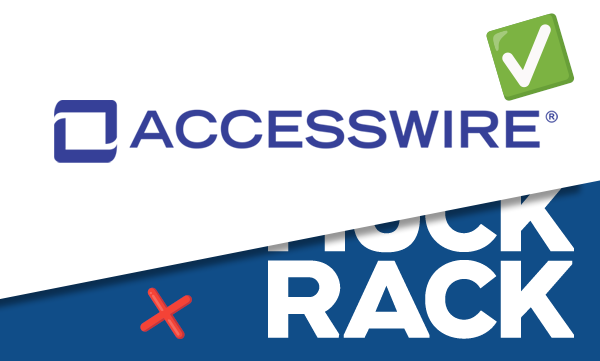A Guide to Press Release SEO
Is your company undergoing a major internal shift? Are you launching a revolutionary new project? Are you on the precipice of a merger, acquisition, or IPO? If you have news worth sharing with your customers, investors, and the general public, press releases are one of the most effective ways to spread the word—quickly, easily, and most importantly, accurately.
But in the digital age, even formal press releases require an in-depth SEO public relations strategy.
When you submit a press release, it will likely live on your website but the hope is also that others promote it socially and use it journalistically as a source of news, sharing it far and wide to increase its impact. In this guide, we’ll cover SEO best practices to help your press release distribution earn you the coverage you deserve in today’s digital landscape.
The Gold Standard of Press Releases: What You Hope to Achieve Through SEO
At its most basic, your press release will appear on your own website, social media, on a Press or Current News site page,in its entirety. But beyond that, there's an immense opportunity for the seed of your press release to grow into something much larger, as long as you plant and water it properly.
A well-crafted press release could become:
- A cut-and-paste article in a trade magazine or journal
- An article on a general news site that also mentions competitors
- A blurb and link on an industry website or newsletter
- A blog post that includes personal opinion and reaction
- A mention on a social platform
When large blocks of your press release are shared, copied, and quoted across the web, this serves to:
- Multiply the internet locations that showcase your brand or products and help guide potential customers to you.
- Drive inbound links to your site, which helps search engines understand your brand’s authentic expertise and optimize your site accordingly. 1
- Create a digital footprint of established outside sources, which boosts your brand’s trustworthiness and authority
To ensure your press release crosses the right desks and, in this day and age, screens, you have to craft and present a piece of content that implements SEO best practices.
#1 Optimize the First 250 Words
A good press release should be short and snappy. No more than 500 words. Unless you’re a fortunate 500 with established brand credibility, neither readers, journalists, nor algorithms will likely be willing to read a lengthy treatise on whatever it is your company is doing. Therefore, from both a content and SEO standpoint, it’s essential that you front-load all of the important information.
- For search engines – Algorithms are looking to confirm that they’re showing the right content by rating the first 200 to 250 words of your press release. By providing the most valuable and relevant content from the outset, you ensure that algorithms will catch it and immediately understand what the press release is about.
- For journalists – A journalist may receive dozens if not hundreds of press release queries on a weekly basis—all of which implicitly promise an amazing story. So, if you’re blindly submitting a press release to a journalist who you don’t have an established relationship with, they’ll likely look for reasons to reject it. But, if you provide a drag and drop piece that hooks them and has already done most of the groundwork, it’ll be a much more difficult decision for them to pass on the story.
- For readers – The average reader has a limited attention span. Just like with any type of content, you must provide readers with a clear, direct topic summary that encourages them to keep reading. You want to grab their attention, convey your point, and then get out while you’re ahead. Because even if the piece is brief and compelling, there’s no guarantee that it’ll be read to the end.
So, what does that look like? How do you write a press release exactly?
When we write a friendly press release, we take our cue from journalists. You’ll want to hit the basic questions—or the “five Ws”:
- What – A big-picture overview of your recent launch, announcement, or change.
- Who – The various parties involved.
- When – Any key dates, as well as why the information is critical now.
- Where – The jurisdictions that are impacted by the news.
- Why – The reason readers should care.
These details entice readers and search engines alike—when creating an SEO press release strategy, you have to consider that these are both your target audiences.
#2 Incorporate Logical Keywords that Your Target Audience Will Likely Search
Keywords are naturally key to your business, and the same ones likely pop up across platforms and content types. However, the circumstances, objectives, and intended audience of a piece of content should dictate which keywords you focus on—with a press release, you’re looking at a very specific set of conditions:
- The information is brand new, so the keywords should be evergreen – Press releases are generally used to announce something important—something the public doesn’t know about yet. You can’t expect them to search for your new product by name. Instead, you’ll want to focus on generic, unbranded keywords that describe the product using terminology the average user might search.
- News outlets look for press releases using industry-standard keywords – If journalists are looking for a story, they’ll likely search for broad, industry-standard keywords rather than hyperspecific terminology. You’ll want to use widely accepted keywords over terms developed by your internal team or trademarked by your company.
- You can capture a wider target audience with adjacent keywords – If there is a regulatory change or current news issue at the heart of your announcement, include that specific language, especially if your new development solves their pain point. When users are searching for industry updates or regulatory guidance, they may inadvertently stumble across your carefully targeted press release.
- Use long tail keywords – Internet search behavior has changed over time. And so too have the search algorithms in response. Today, more than 70% of all internet searches are conducted using a long-tail query—that means three or more keywords or an entire phrase. Long Tail keywords are more specific, which yield more targeted and relevant results. So, as you perform keyword research, focus on including language that is likely to answer long-tail queries.
#3 Research and Include High-Traffic Keywords to Outrank Competitors
It’s likely your competitors are equally focused on serving up solutions and answers to your shared target audience—and it’s practically guaranteed that they’re using valuable keywords to do it, too.
To ensure your press release is competitive, conduct research into the most popular keywords and press releases in your industry:
- Identify the highest SEO ranking press releases from your competitors then incorporate their keywords into your copy.
- Look into the phrases and terms that are the most popular and expensive to bid on through search engine advertising. You don’t have to pay a cent to simply include these high-dollar keywords in your next press release.
#4 Link Build via Distributed Press Releases
Just like with your web copy and blog content, press releases SEO can be strengthened via link building strategies.
How does that work?
Start by adding optimized backlinks in the press release body copy to the most relevant pages on your website domain, you can help both the press release and the web page rank higher on organic search. Also, incorporate an optimized anchor text for the link. Doing so will boost your site’s domain every time the release is posted, shared, or written about.
#5 Don’t Overdo Keywords Or Links
To optimize a press release for SEO, keywords are essential. But proper keyword volume is every bit important as the words themselves—sometimes, even more so.
For starters, an excessive amount of keywords and links will render the piece unpalatable for the reader. And since Google’s increasingly prioritizing readability in content, keyword stuffing would likely ding your content score, if not get it pulled for blackhat practices. According to Matt Cutts, head of Google’s webspam team:
“When the keyword is mentioned the first time the algorithm will take notice, the second time it is looking for relevancy, the third time it may diminish your results. Think of the keywords you would like in your copy in a natural way. My recommendation is to read it out loud, read it to someone else, or have someone read it to you. Look for something artificial that does not read right. I would love it if people could stop focusing on keyword density.”
Remember, the quality of content should always take precedent before SEO.
#6 Write Headlines for Humans and Search Engines
With so much available information, we have limited attention spans and are prone to making snap judgments—continue reading or look for something more compelling? We don’t often spend more than a few moments making this decision, and most of that time is a cursory glance.
Just like humans, search engines are looking for signs that they’ve hit the right page by identifying keywords and phrases. But the large text blocks that are typical of press releases can make this particular task difficult. As press releases evolve for the digital age, there’s no reason not to use formatting and arrangement principles to help readers—both human and robot—easily scan and comprehend your critical points.
Consider these press release SEO best practices for next time:
- Incorporate the most relevant and eye-catching details and keywords in headlines and subheadings. Search engines recognize that headers are more important than paragraph text and will give higher value to keywords included therein.
- Use bolded, italicized, or otherwise emphasized fonts to highlight critical concepts throughout the copy.
- Concentrate keywords and phrases near the top of the page—“above the fold”—where users will easily see it without having to scroll down at all. However, you also want to spread keywords evenly and organically throughout the press release to avoid getting dinged for “keyword stuffing.”
#5 Present Your Announcement in a Newsworthy Way
No amount of bells, whistles, or keywords will help if you’re not giving the readers what they want: content that is truly worthy of a press release distribution. For more information on how to distribute a press release effectively, follow our tips below.
Before you craft your upcoming press release, ask yourself if it:
- Impacts your customers, partners, or investors in a meaningful way?
- Creates new efficiencies, saves resources, or improves productivity?
- Helps solve a problem?
If you’re sharing company or employee achievements or updates, craft your press release writing in a way that is genuinely interesting to your audience. If readers constantly click your page, find themselves bored, and immediately return to the search results page, Google takes this high bounce rate as a clear indication that your press release is not of interest—and therefore, not worth ranking among the top results of Google’s SERP. 2
To create user- and SEO-friendly press release content, try to answer the following:
- What is the real-world impact of this change, decision, or update? Explain how this could improve lives, help companies thrive, reduce expenses, and so on. Use projected statistics, if available.
- What proof do you have to support this conclusion? Back up your claims with concrete data that the average reader can connect to, such as successful results from beta testing.
- What can users look forward to, thanks to this new development? Talk about special events, giveaways, service improvements, charitable donations, and other exciting updates.
#6 Optimize Your Text and Images According to SEO Requirements
Beyond the high-quality copy itself, an SEO-friendly press release will have several technical components. Make sure your next announcement checks the following boxes:
- Official company header and footer – Begin by setting up a fresh template that includes your brand’s official header and footer in its most basic, black and white versions. This will keep the file size down and keep the focus on your news.
- Meta description – Add a compelling meta description to your press release that is short enough to fit on a search engine’s main page, while still incorporating your most important targeted keyword and a summary of the press release.
- Title tag – This is yet another opportunity to include important information in a prominent place on your online press release.
- Appropriate hyperlinks – If your press release is picked up and republished by other news outlets or media coverage, this is a great way to earn your company some high-quality backlinks—however, this only works if you’ve incorporated call-to-action hyperlinks in your original copy.
- Digestible infographics – A clear and well-designed infographic can help capture the eye of quick-scanning readers and reach those who process information visually. Ensure your image is:
- Relevant and connects to the text on the page
- Appropriately titled and captioned
- Unique and appealing
- SEO-optimized images – At a more technical level, you’ll need to ensure that any visuals you use are:
- Optimized for the best image quality at the lowest file size
- Titled with an SEO-friendly file name
- Equipped with alternative text (alt tag) for accessibility
Each time you need a fresh press release, copy your template file and begin with a clean version to showcase your news.
Example of an Excellent SEO-Optimized Press Release
-----
CACAO Brings Back the Wonder of Wonka
World-famous chocolatier CACAO is recreating Willy Wonka’s chocolate factory
London, January 17th, 2022
The spirit of Willy Wonka has returned in CACAO’s latest worldwide contest. Chocolate manufacturer CACAO will be welcoming a select few into its factory for an extravagant event that so far has only existed in fiction.
The game is on.
Hidden among the next million original CACAO bars manufactured are five Ruby Tickets. The holder of each gilded ticket will win a lifetime supply of CACAO chocolate. And as if that weren’t enough, it’ll grant one child—as well as an adult chaperon of their choice—entry past the gates of the fabled CACAO Chocolate Factory. From there, the five lucky winners will get to meet the team behind the world’s most beloved chocolate bar and be taken on a guided tour of a sugary world that stretches beyond their wildest imaginations.
CACAO CEO Lisa Tilde had this to say, “We’re thrilled to bring a little CACAO magic to life and hope kids (and kids at heart) can enjoy this initiative.”
The contest will go until all five tickets have been found and verified. Start buying CACAO OriginalTM bars today for your own chance at an adventure of a lifetime!
About CACAO Chocolates Incorporated
CACAO has been the world’s leading producer of organic chocolate bars and assorted candies for more than three decades. With smaller factories and distribution centers in every major nation and more than 2.3 trillion units sold to date, CACAO Chocolate Inc. has steadily climbed to the top of the Fortune 500 list.
-----
Increase the Success of Your Next Press Release with ACCESSWIRE
Whether you’re building customer and investor relations or want to make a splash with big news, an effective press release remains an invaluable way to get the word out.
Through specialized targeting on the front end and PR measurement or analytics after the fact, it’s essential to demonstrate the effectiveness of your efforts in the age of data-driven decisions. ACCESSWIRE helps clients distribute their press releases on valuable channels, maintain full compliance, and unlock necessary insights into performance and improve opportunities.
Sources:
Google Search Console. Steps to a Google-friendly site
WE ANALYZED 11.8 MILLION GOOGLE SEARCH RESULTS: Here’s What We Learned About SEO
Content Marketing Institute. 9 Steps to Optimize Images for SEO
Similar Blog Posts



PRODUCTS
ACCESSWIRE | All Rights Reserved

